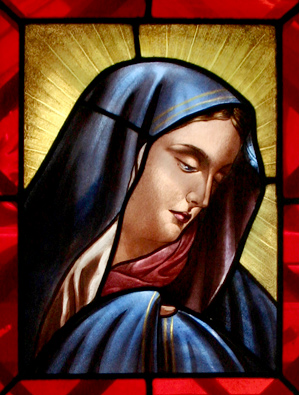
Documenting Recoleta Cemetery in Buenos Aires since 2007
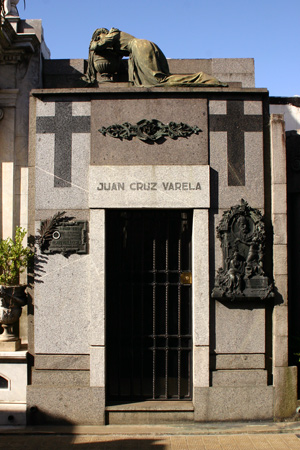
Born in Buenos Aires in 1794, Juan Cruz Varela was sent by his parents to Córdoba to become a priest. But Varela completed his studies in 1816 just as Argentina won its independence from Spain & so chose to participate politics & literary ventures instead. Many scholars have classified his odes & tragedies as the best early Argentine literature written. Works often tackled the topics of the day, mainly the revolutionary wars & struggles of the new nation. In “Canto lírico al triunfo de Ituzaingó,” Varela describes General Carlos Alvear‘s victorious battle against Brazil & later wrote a eulogy for Manuel Belgrano:
¿Oh, dónde habitas, militar guerrero?
¿Cómo te fuiste, y huérfana dejaste
tu amada patria, que a la vez libraste
con los cortantes filos de tu acero?Cómo le has dado el golpe postrimero,
e insensible a su llanto te ausentaste,
abandonando al último contraste
su libertad, su honor, su bien entero.Que se encienda de nuevo, que se encienda
la antorcha de tu vida. Y si es en vano
nuestro justo clamor en la contiendade tu afligida patria, pon la mano
sobre quien te suceda, y la defienda.
¡Pero quien te sucede, gran Belgrano!
As a friend & admirer of first President Bernardino Rivadavia, Varela was forced into exile with Rivadavia’s political defeat & the rise of Rosas. He died in Montevideo in 1839, & his remains were brought to Recoleta Cemetery after the defeat of Rosas.
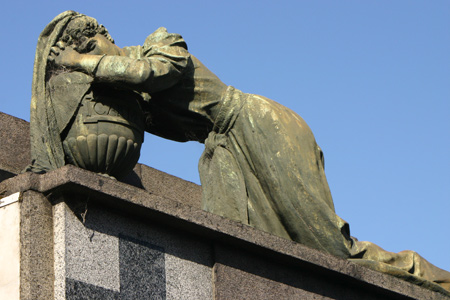
An equally interesting descendant of Varela also buried in the family tomb is Dalmiro Varela Castex. A large plaque hints to his importance:
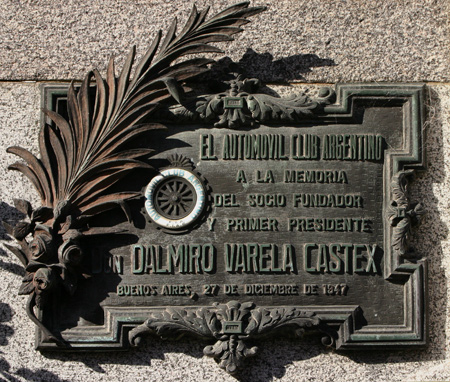
Dalmiro imported the first vehicle to Argentina in 1888, a steam-powered De Dion Bouton tricycle. In 1895 he imported a petrol-powered Benz four-wheeled vehicle & sold the tricycle to Marcelo T de Alvear. Importing & selling vehicles would become Dalmiro’s passion. In 1904, he founded the first automotive group, the Automovil Club Argentino (ACA) & was issued the first driver’s license in the nation:
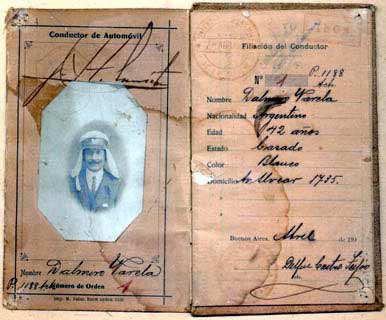
For more info on Dalmiro & the history of automobiles in Argentina, Daniel Costa Deschamps has written an interesting memoir on the topic (in English). Above photo courtesy of prewarbuick.com. This tomb was declared a National Historic Monument in 1946.
Update (08 Feb 2012): Apparently this tomb was downsized. Part of the original gate was maintained & the mourning woman statue placed on top of the whole structure. It’s always looked a bit odd to me & thanks to photo #371 of the Witcomb Collection now I understand why:
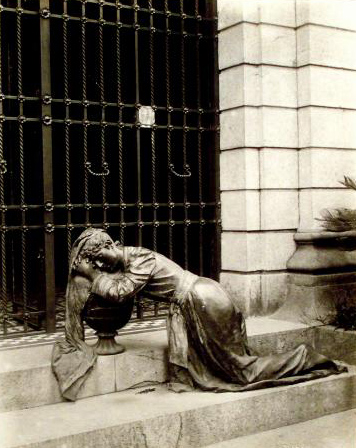
Apparently Remedios de Escalada isn’t the only one who receives a birthday bash. Tourists had no problem finding the unmarked tomb of Eva Duarte de Perón today thanks to the large number of wreaths spilling into the main walkway:
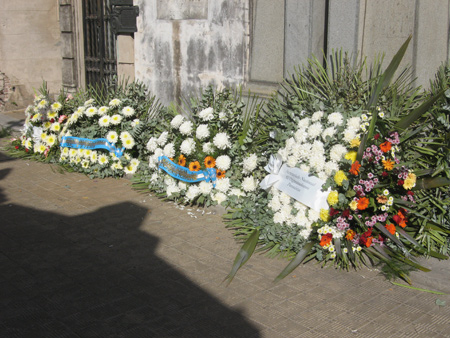
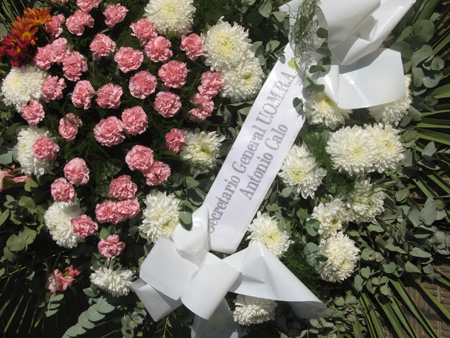
Eva Duarte was born this day in 1919 & is firmly entrenched not only in Argentine history but also in pop culture. A musical based on your life does that kind of thing. Copies of famous photos lined the way to her tomb, dressed to the nines. The pic that most caught my attention was taken from the balcony of the Palacio Real in Madrid during her state visit to meet Francisco Franco:
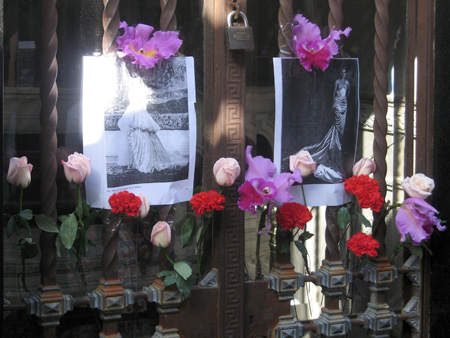
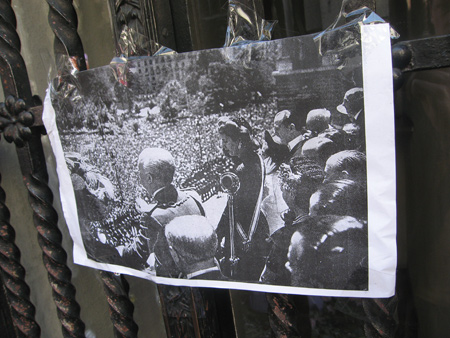
A woman with silver tennis shoes, a track suit & fuzzy poncho added to the spectacle. She was talking with other Argentines & tending to Eva’s tomb… taking flowers from the wreaths & placing them in every nook & cranny she could find. It all seemed a bit over the top:
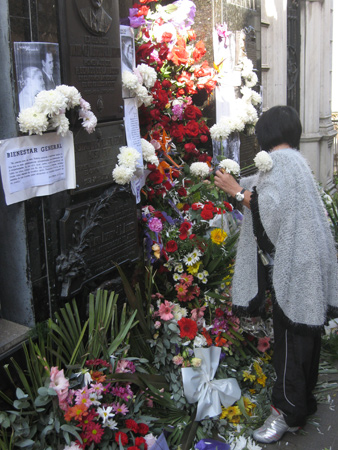
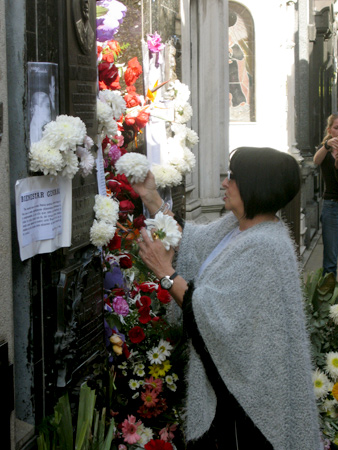
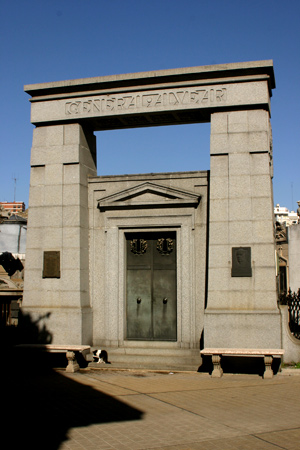
Built by Alejandro Christophersen, this gargantuan granite temple has housed the remains of the Alvear family over three generations. Its size adequately reflects the importance of this family. A nearby avenue named after them is synonymous for upper class elegance with expensive design shops, a few embassies, & the Jockey Club all sharing the same address.
The general referred to on the cornice was Carlos María de Alvear, a controversial fighter for Argentine independence & frequently at odds with founding father José de San Martín. With a life worthy of being made into an epic movie, Carlos acquired the status of national hero for winning campaigns during the 1827 Argentina-Brazil War. He died in Washington, DC in 1852 while serving Argentina’s first ambassador to the United States.
One of Carlos’s most important sons was Torcuato de Alvear, also buried in the family mausoleum. As the first mayor of Buenos Aires after it became the nation’s capital, Torcuato instituted wide-sweeping improvements: constructing Avenida de Mayo down the middle of a city block, demolishing the old marketplace in the main square, & commissioning the large entrance gate for Recoleta Cemetery. Since Torcuato ordered cemetery improvements, he made sure to place his family’s mausoleum in front.
One of Torcuato’s sons became President in 1922. Marcelo T. de Alvear is remembered for leading a period of economic & cultural prosperity. Although part of the upper class, Marcelo became instrumental in shaping the Socialist-leaning Unión Cívica Radical party.
Declared a National Historic Monument in 1946, all generations of the Alvear family can watch everyone coming & going from their prime position:
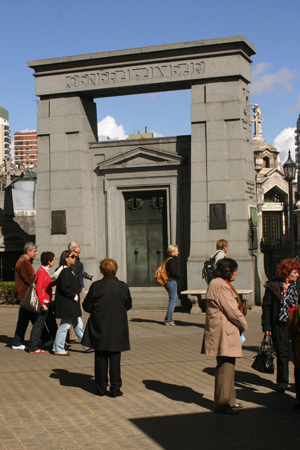
Sponsored by the Dirección General Patrimonio & Instituto Histórico, a series of five free lectures about death in Buenos Aires began yesterday. Naturally, I’ll be attending all of the talks… if anyone wants to join me, just send me an email. They take place every Friday from 18:30–20:00 at the Instituto Histórico (Avenida Córdoba 1556, 1º piso). Topics to be discussed are:
May 02 • “Los enterratorios en los siglos XVII y XVIII; las costumbres funerarias de la época” by architect Julio Cacciatore
May 09 • “Vida y muerte de negros y esclavos” by archaeologist Daniel Schávelzon
May 16 • “Los cementerios protestantes” by Dr. Maxine Hanon, “Los cementerios judios” by anthropologist Leonor Slavsky, & “Cementerios olvidados del norte y del sur” by Luis Cortese
May 23 • “Los cementerios de Flores” by neighborhood historian Ángel Prignano & “Los cementerios de Chacarita” by architect Julio Cacciatore
May 30 • “Historia y arte en el cementerio de la Recoleta” by cemetery director Dr. Carlos Francavilla & “Patrimonio narrativo del cementerio de la Recoleta” by Dr. María Rosa Lojo.
Even though some of the lectures do not relate directly to Recoleta Cemetery, I will post my notes since comparison & contrast always provide insight. There were over 50 people present for the first talk, so go a little early to get a good seat. Maybe I’ll see you there!
Leave a Comment